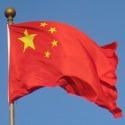
It is China's 14th five-year plan.
And even Beijing couldn't pass up the chance to make it about 5G. That has the benefit of building on an existing national advantage: China now has 341 5G-connected cities, compared to 279 in the US.
And with plentiful cheap-and-cheerful 5G devices, the percentage of China's population carrying them leads other countries hands down.
So continuing to set up 5G basestations will help China ensure it remains the factory floor of the world, which is also an area of advantage for a country with a 30% share of global manufacturing – about the same as the US, Japan and Germany put together.
Meanwhile Chinese telcos are expected to build over 1 million new 5G basestations in 2021, as the cost of doing so shrinks.
China Mobile now has 173.16 million 5G subscribers, while its rival China Telecom has 103.37 million. China Unicom has 84.3 million.
Building millions of 5G stations will boost information exchange, spur tech advances, and lead whole industries to flourish, instead of a mere handful of firms, says the state-backed Global Times.
Otherwise, for a modern China that has never been so powerful, its plan has never been so modest.
Where do you see yourself in five years?
Maybe with maturity comes realism.
"China can now look the world in the eye," Xi Jinping told a small group during last month's annual session of the National People's Congress.
"It's not like back in the day, when we were all bumpkins," he added.
Part of this new realism is how basic research now gets a look-in. The plan calls for boosting this up above 8% of total R&D spend.
China currently spends over 80% in research and development tied to particular commercial products and processes, and 11% on applied research.
By comparison, the US and other leading advanced economies spend around 20% of their R&D money on basic research.
And R&D as a whole is only 2.4% of China's GDP.
This is well behind countries like Israel and South Korea at 4%, the US at 3%, and China's own 2015 five-year plan's goal of 2.5%.
Focusing on basic research is a must for China, but its scientific community is still finding its feet, too.
China "produces a disproportionate number of faked peer reviews and plagiarized or fraudulent publications," says Nature.
And its share of retracted papers "is around three times that expected from its scientific output," it adds.
How about five one-year plans?
Instead of setting a half decade's worth of average yearly growth targets, a centerpiece of earlier plans, Beijing says it will now set growth targets each year.
These will be based on "conditions," it says. For that, read "geopolitics."
Washington, cutting off China's cutting-edge processor supply, last year effectively kicked Huawei out of the smartphone market.
That China was just made brutally aware of how much it depends on overseas semiconductors shows in its mentions of the danger of "hegemonism."
But for all this, this plan doesn't envisage, say, 20% year-on-year growth in the semiconductor industry. (A previous one did. It didn't happen.)
If you build it they will come
Building top-tier national infrastructure as a way of maintaining China's industrial advantage is an area where Beijing has form.
The transport ministry, for example, is already aiming to double the length of China's high-speed rail network in 15 years, bringing it up to 70,000km (43,000 miles).
Self-sufficiency against "hegemonism" appears almost reassuringly old-school.
Interested in Asia? Check out our dedicated content channel here on Light Reading.
But there are tiny indications of, at least domestically, market forces that might be unleashed.
China's hukou system, a registry making it harder for rural dwellers to settle in cities, will be balanced out a bit with a points-based system making internal migration easier for educated, young workers.
And that tiny footnote may end up being one of the most important parts of the plan.
Related posts:
— Pádraig Belton, contributing editor special to Light Reading
Read more about:
AsiaAbout the Author(s)
You May Also Like











